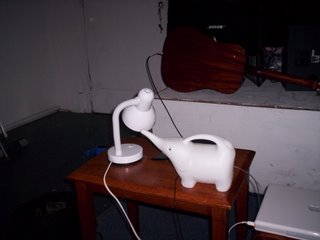
As part of the Tyndall Assembly series of concert, Hidden Village (Sebastian Tomczak and Lauren Sutter) performed live last Thursday. The work we performed was Duet for Two Desk Lamps and was received quite well. Lauren and I were quite happy with it, considering that it was very quickly prepared, since I had burnt out/ hacked up/ trashed all of my lasers for the Toriton piece (see previous post about using water as a controller). Christian Haines and Tristan Louth-Robins also had pieces in this concert.
Duet for Two Desk Lamps used two standard lights (Kambrook KDL30W- 60W- $11.86) from Big W as music controllers. Two solar panels from Dick Smith (0.45Vk, 1A- o2001- $6.99) were wired directly to two RCA leads (just ones I bought from cheap as chips or whatever for $2 for 3). The ground went to (-) and the signal went to (+), but this could be the other way around also.
Both of us were controlling four oscillators each. This bank of four consisted of:
- One sine wave whose frequency was set, but whose amplitude was directly modulated from the solar panel. (osc 1)
- One sine wave whose frequency was dependent on the average peak over the previous second from the solar module; the higher the peak, the higher the frequency. Also, the amplitude was directly modulated from the solar panel. (osc 2)
- Two sine waves whose frequencies were dependent on the average peak over the previous 3- 10 seconds from the solar module of the other player; the higher the peak, the higher the frequency. Also, the amplitude was directly modulated from the solar panel. (osc 3 + 4)
Average amount of energy generated by the solar panels also controlled delay time in an asymetric feedback network. The amount of energy change currently coming from the solar module also controls the amount of feedback seen in this network.
Control was exerted in the piece via two main techniques. Either the lamp was turned on and off (to produce more 'blips' in the directly controlled sine waves), or the lamp's neck was quickly moved back and forth, so that the outer edge of the spotlight was constanltly moving on and off the solar panel (thus, a more shimmering and gradual effect over the sound can be achieved).
The piece has the following form
- Technique: Clicking, Osc 1a and 1b, then 1a, 1b, 3a and 3b, 2mins
- Technique: Waving, Osc 2a and 2b, then 2a, 2b, 4a and 4b, 2mins
- Technique: Clicking and Waving, All osc simultaneously and alternating, 3mins
Next week: Shivna Kaun and The Glitch Collective...


0 comments:
Post a Comment